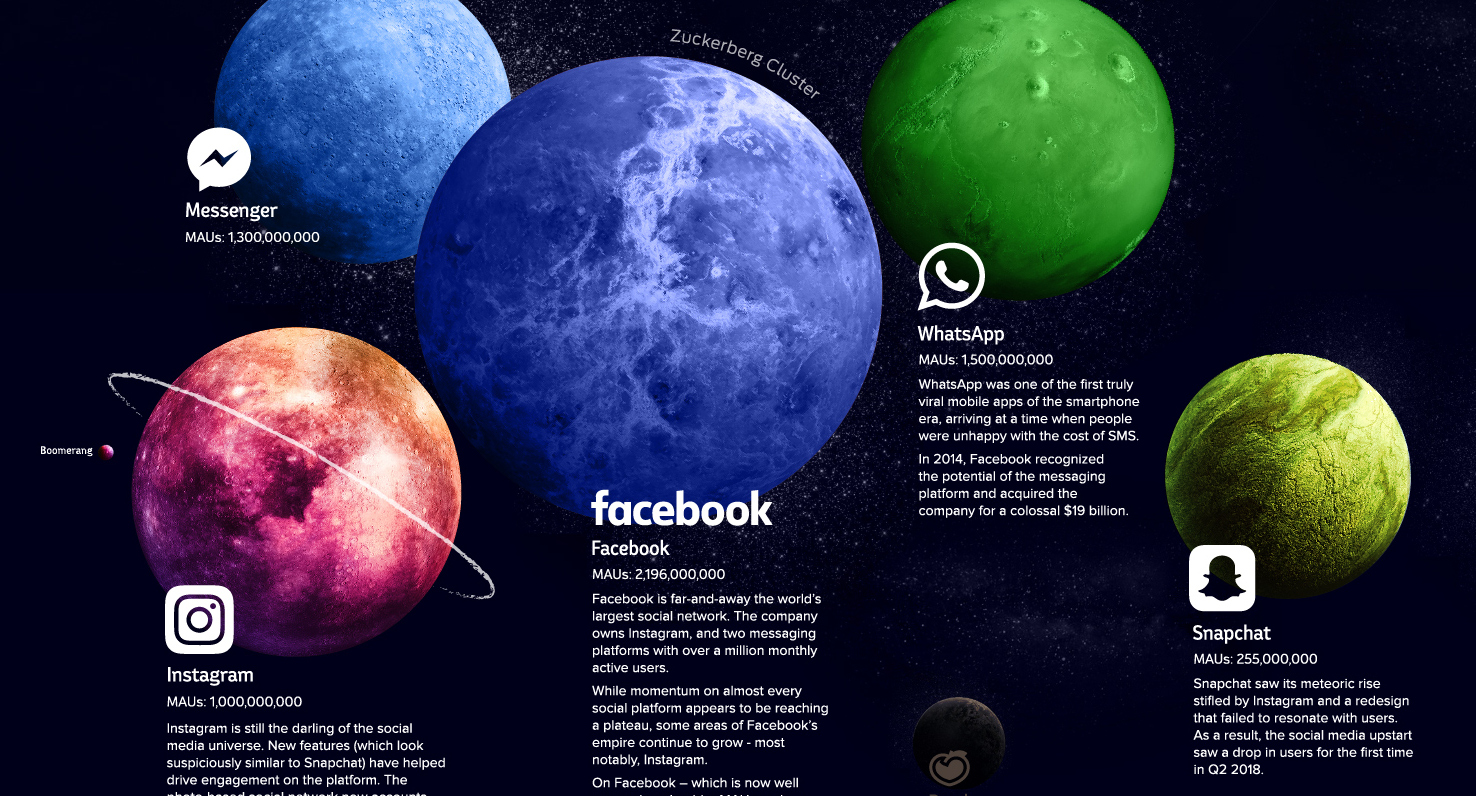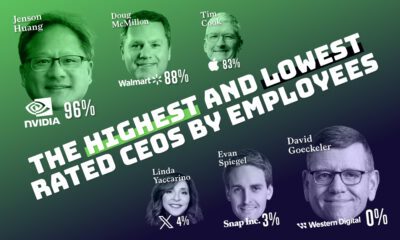Technology
Visualizing the Social Media Universe in 2018
View a high resolution version of this graphic

The Social Media Universe: 2018
View the high resolution version of today’s graphic by clicking here.
Billions of people around the world grew up during the age of social media, and mankind is slowly marching toward a future where nearly everyone will be a digital native.
For the one-third of humanity that now uses a smartphone, messaging and status updates are often more natural than having a live conversation. In a world where social interactions are peppered with emojis and funneled through a front-facing camera, the platforms we use become more than mere service providers; they are the connective tissue of our society.
What services are people using to communicate?
Monthly active users (MAUs) is a metric commonly used to evaluate how many people are using a service regularly. Here are the world’s top social and messaging platforms by MAUs:
| Rank | Social Network | Monthly Active Users (MAUs) |
|---|---|---|
| #1 | 2.2 billion | |
| #2 | YouTube | 1.9 billion |
| #3 | 1.5 billion | |
| #4 | Messenger | 1.3 billion |
| #5 | 1.0 billion | |
| #6 | 1.0 billion | |
| #7 | 806 million | |
| #8 | Qzone | 563 million |
| #9 | Douyin | 500 million |
| #10 | 411 million | |
| #11 | 366 million | |
| #12 | 330 million | |
| #13 | Baidu Tieba | 300 million |
| #14 | 294 million | |
| #15 | Viber | 260 million |
| #16 | Snapchat | 255 million |
| #17 | Line | 203 million |
| #18 | Telegram | 200 million |
| #19 | 200 million | |
| #20 | YY | 117 million |
| #21 | VK | 97 million |
Let’s take a closer look at these massive platforms.
The Facebook Empire
On its own, Facebook is a behemoth, but adding in the other platforms run by Mark Zuckerberg paints a clear picture of who controls the social media in 2018.
During its growth spurt in the late aughts, Facebook emerged as the first truly global social networks, hitting one billion monthly active users and essentially popularizing the idea of social media. These days, Facebook appears to be hitting engagement and growth plateaus, but acquisitions such as Instagram and WhatsApp are fueling growth for the company, with the former accounting for over a third of revenue.
In China, WeChat isn’t just a typical messenger app.
This “super app” – which facilitates everything from point-of-sale purchases to accessing public services – is likely the template that other social platforms around the world will emulate as they strive for more thorough integration with their users’ lives.
Because WeChat is typically also used for work, the average user spends about an hour in-app each day. That is a level of engagement most platforms can only dream of.
The “Front Page of the Internet” has grown up.
The oft controversial message board – created in 2005 – is now worth an estimated $1.8 billion, and is contemplating an IPO in the near future. While the company does make money from advertising, a unique membership feature called Reddit Gold is helping bring in funding directly from the community.
When people have something to say publicly or look to debate big issues in the news cycle, more often than not, they use Twitter. Tweets from world leaders and CEOs can have far-reaching consequences, and hashtagged social movements have united more people than ever to affect change. For better or worse, Twitter fills an important role in modern society.
Unfortunately for Twitter, great responsibility has translated into greater scrutiny rather than strong revenue growth. The company has faced high profile controversies over harassment, bots, and fake news, and has struggled to match the sky-high growth expectations set when the “microblogging” platform went public in 2013. Twitter is still experimenting with new ways to monetize its 300+ million active user base.
SnapChat
In 2015, Snapchat, having already thoroughly conquered the under-18 market, looked set to disrupt the social media landscape. What came next was a tragedy in two acts.
First, Instagram released its Story feature that same year, effectively cloning Snapchat’s features and layout within their app. Many users, who had only recently began using novel new platform, flocked back to Instagram where they already had a developed following.
Secondly, a redesign of the Snapchat interface was widely criticized by high profile users, speeding up an exodus to Instagram.
Snapchat, which has since gone public, still has a quarter of billion MAUs, but questions remain about whether the platform can recapture the magic of their earlier years.
Technology
All of the Grants Given by the U.S. CHIPS Act
Intel, TSMC, and more have received billions in subsidies from the U.S. CHIPS Act in 2024.

All of the Grants Given by the U.S. CHIPS Act
This was originally posted on our Voronoi app. Download the app for free on iOS or Android and discover incredible data-driven charts from a variety of trusted sources.
This visualization shows which companies are receiving grants from the U.S. CHIPS Act, as of April 25, 2024. The CHIPS Act is a federal statute signed into law by President Joe Biden that authorizes $280 billion in new funding to boost domestic research and manufacturing of semiconductors.
The grant amounts visualized in this graphic are intended to accelerate the production of semiconductor fabrication plants (fabs) across the United States.
Data and Company Highlights
The figures we used to create this graphic were collected from a variety of public news sources. The Semiconductor Industry Association (SIA) also maintains a tracker for CHIPS Act recipients, though at the time of writing it does not have the latest details for Micron.
| Company | Federal Grant Amount | Anticipated Investment From Company |
|---|---|---|
| 🇺🇸 Intel | $8,500,000,000 | $100,000,000,000 |
| 🇹🇼 TSMC | $6,600,000,000 | $65,000,000,000 |
| 🇰🇷 Samsung | $6,400,000,000 | $45,000,000,000 |
| 🇺🇸 Micron | $6,100,000,000 | $50,000,000,000 |
| 🇺🇸 GlobalFoundries | $1,500,000,000 | $12,000,000,000 |
| 🇺🇸 Microchip | $162,000,000 | N/A |
| 🇬🇧 BAE Systems | $35,000,000 | N/A |
BAE Systems was not included in the graphic due to size limitations
Intel’s Massive Plans
Intel is receiving the largest share of the pie, with $8.5 billion in grants (plus an additional $11 billion in government loans). This grant accounts for 22% of the CHIPS Act’s total subsidies for chip production.
From Intel’s side, the company is expected to invest $100 billion to construct new fabs in Arizona and Ohio, while modernizing and/or expanding existing fabs in Oregon and New Mexico. Intel could also claim another $25 billion in credits through the U.S. Treasury Department’s Investment Tax Credit.
TSMC Expands its U.S. Presence
TSMC, the world’s largest semiconductor foundry company, is receiving a hefty $6.6 billion to construct a new chip plant with three fabs in Arizona. The Taiwanese chipmaker is expected to invest $65 billion into the project.
The plant’s first fab will be up and running in the first half of 2025, leveraging 4 nm (nanometer) technology. According to TrendForce, the other fabs will produce chips on more advanced 3 nm and 2 nm processes.
The Latest Grant Goes to Micron
Micron, the only U.S.-based manufacturer of memory chips, is set to receive $6.1 billion in grants to support its plans of investing $50 billion through 2030. This investment will be used to construct new fabs in Idaho and New York.
-

 Debt1 week ago
Debt1 week agoHow Debt-to-GDP Ratios Have Changed Since 2000
-

 Markets2 weeks ago
Markets2 weeks agoRanked: The World’s Top Flight Routes, by Revenue
-

 Countries2 weeks ago
Countries2 weeks agoPopulation Projections: The World’s 6 Largest Countries in 2075
-

 Markets2 weeks ago
Markets2 weeks agoThe Top 10 States by Real GDP Growth in 2023
-

 Demographics2 weeks ago
Demographics2 weeks agoThe Smallest Gender Wage Gaps in OECD Countries
-

 United States2 weeks ago
United States2 weeks agoWhere U.S. Inflation Hit the Hardest in March 2024
-

 Green2 weeks ago
Green2 weeks agoTop Countries By Forest Growth Since 2001
-

 United States2 weeks ago
United States2 weeks agoRanked: The Largest U.S. Corporations by Number of Employees
















